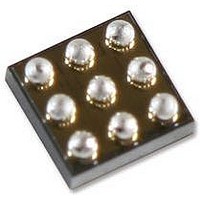LM4673TM National Semiconductor, LM4673TM Datasheet - Page 12

LM4673TM
Manufacturer Part Number
LM4673TM
Description
AUDIO AMP, MONO CLASS D, POWERWISE
Manufacturer
National Semiconductor
Datasheet
1.LM4673TM.pdf
(24 pages)
Specifications of LM4673TM
Operational Class
Class-D
Audio Amplifier Output Configuration
1-Channel Mono
Output Power (typ)
2.65x1@4OhmW
Audio Amplifier Function
Speaker
Total Harmonic Distortion
0.03@8Ohm@0.1W%
Single Supply Voltage (typ)
3/5V
Dual Supply Voltage (typ)
Not RequiredV
Power Supply Requirement
Single
Rail/rail I/o Type
No
Power Supply Rejection Ratio
78dB
Single Supply Voltage (min)
2.4V
Single Supply Voltage (max)
5.5V
Dual Supply Voltage (min)
Not RequiredV
Dual Supply Voltage (max)
Not RequiredV
Operating Temp Range
-40C to 85C
Operating Temperature Classification
Industrial
Mounting
Surface Mount
Pin Count
9
Package Type
uSMD
Amplifier Class
D
No. Of Channels
1
Output Power
2.65W
Supply Voltage Range
2.4V To 5.5V
Thd + N
0.03% @ 100mW, VDD=5V
Load Impedance
4ohm
Operating Temperature Range
-40°C To +85°C
Rohs Compliant
Yes
Lead Free Status / Rohs Status
Not Compliant
Available stocks
Company
Part Number
Manufacturer
Quantity
Price
Part Number:
LM4673TM
Manufacturer:
NS/国半
Quantity:
20 000
Part Number:
LM4673TMX
Manufacturer:
NS/国半
Quantity:
20 000
Part Number:
LM4673TMX/NOPB
Manufacturer:
TI/德州仪器
Quantity:
20 000
www.national.com
due to the internal shutdown resistor can be found by Equa-
tion (1) below.
With only a 0.5V difference, an additional 1.7µA of current will
be drawn while in the shutdown state.
PROPER SELECTION OF EXTERNAL COMPONENTS
The gain of the LM4673 is set by the external resistors, Ri in
Figure 1, The Gain is given by Equation (2) below. Best THD
+N performance is achieved with a gain of 2V/V (6dB).
It is recommended that resistors with 1% tolerance or better
be used to set the gain of the LM4673. The Ri resistors should
be placed close to the input pins of the LM4673. Keeping the
input traces close to each other and of the same length in a
high noise environment will aid in noise rejection due to the
good CMRR of the LM4673. Noise coupled onto input traces
which are physically close to each other will be common mode
and easily rejected by the LM4673.
Input capacitors may be needed for some applications or
when the source is single-ended (see Figures 3, 5). Input ca-
pacitors are needed to block any DC voltage at the source so
that the DC voltage seen between the input terminals of the
LM4673 is 0V. Input capacitors create a high-pass filter with
the input resistors, R
is found using Equation (3) below.
The input capacitors may also be used to remove low audio
frequencies. Small speakers cannot reproduce low bass fre-
quencies so filtering may be desired . When the LM4673 is
using a single-ended source, power supply noise on the
ground is seen as an input signal by the +IN input pin that is
capacitor coupled to ground (See Figures 5 – 7). Setting the
high-pass filter point above the power supply noise frequen-
cies, 217Hz in a GSM phone, for example, will filter out this
noise so it is not amplified and heard on the output. Capacitors
with a tolerance of 10% or better are recommended for
impedance matching.
DIFFERENTIAL CIRCUIT CONFIGURATIONS
The LM4673 can be used in many different circuit configura-
tions. The simplest and best performing is the DC coupled,
A
V
f
(V
C
= 2 * 150 kΩ / R
= 1 / (2πR
SD
i
. The –3dB point of the high-pass filter
- GND) / 300kΩ
i
C
i
) (Hz)
i
(V/V)
(1)
(2)
(3)
12
differential input configuration shown in Figure 2. Equation (2)
above is used to determine the value of the R
desired gain.
Input capacitors can be used in a differential configuration as
shown in Figure 3. Equation (3) above is used to determine
the value of the C
sponse due to the high-pass filter created by C
Equation (2) above is used to determine the value of the R
resistors for a desired gain.
The LM4673 can be used to amplify more than one audio
source. Figure 4 shows a dual differential input configuration.
The gain for each input can be independently set for maxi-
mum design flexibility using the R
Equation (2). Input capacitors can be used with one or more
sources as well to have different frequency responses de-
pending on the source or if a DC voltage needs to be blocked
from a source.
SINGLE-ENDED CIRCUIT CONFIGURATIONS
The LM4673 can also be used with single-ended sources but
input capacitors will be needed to block any DC at the input
terminals. Figure 5 shows the typical single-ended application
configuration. The equations for Gain, Equation (2), and fre-
quency response, Equation (3), hold for the single-ended
configuration as shown in Figure 5.
When using more than one single-ended source as shown in
Figure 6, the impedance seen from each input terminal should
be equal. To find the correct values for C
to the +IN input pin the equivalent impedance of all the single-
ended sources are calculated. The single-ended sources are
in parallel to each other. The equivalent capacitor and resis-
tor, C
nation of all C
(5) below are for any number of single-ended sources.
The LM4673 may also use a combination of single-ended and
differential sources. A typical application with one single-end-
ed source and one differential source is shown in Figure 7.
Using the principle of superposition, the external component
values can be determined with the above equations corre-
sponding to the configuration.
i3
and R
R
i3
= 1 / (1/R
i
values and then all R
i3
C
, are found by calculating the parallel combi-
i3
= C
i
capacitors for a desired frequency re-
i1
i1
+ C
+ 1/R
i2
+ C
i2
+ 1/R
in
i
resistors for each input and
i
... (F)
values. Equations (4) and
in
...) (Ω)
i3
and R
i
resistors for a
i3
connected
i
and R
(4)
(5)
i
.
i











